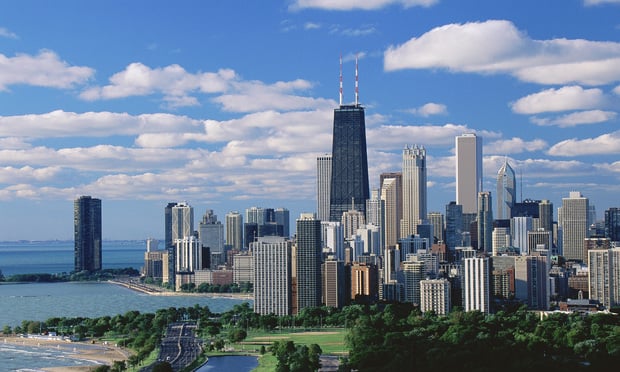
CHICAGO—The upcoming change in administrations has caused some uncertainty among economic forecasters. Sharp changes to any of the trade agreements that govern relations with Mexico, China or Europe could upend current predictions for steady growth. However, stronger Republican support for infrastructure spending could also change expectations for the better by giving an extra boost to the nation's GDP. But infrastructure experts say getting that boost may depend on what gets built, and not just how much is spent.
“There is a lot of speculation about what Trump wants to do with international trade,” Walter Kemmsies, managing director, economist and chief strategist for the US ports, airports and global infrastructure group at Chicago-based JLL, tells GlobeSt.com. He considers it unlikely that major changes are on the way, mainly because “we have a number of industries that are critically dependent on imports.”
But he is keeping a close eye on everything said about transforming US infrastructure. All of this talk has at least opened up the possibility that the continuing damage to our economic potential, done through the neglect of our infrastructure and somewhat misplaced priorities, can be reversed.
For a long time, he adds, “we have been really excited about investing in infrastructure that supports imports.” But when it comes to exports, “we haven't worried much about building the infrastructure needed to do that.”
Although this may seem like a technical argument, choosing to pour capital into export-oriented infrastructure for the nation's seaports, inland ports and rail yards would strengthen the most competitive sectors of our economy, what Kemmsies calls ACE, namely agriculture, capital goods and energy. And doing that would in turn create jobs that balance out the ones lost when companies outsource manufacturing work to Mexico or overseas.
But a lot of work needs to be done, Kemmsies says. American ports, for example, have been dredged adequately enough to accommodate ships arriving from overseas with imported goods. But these ports need to be dredged even further to fully accommodate deep-laden boats carrying the heavier goods typically exported by American companies.
“Fundamentally, if you want to change things, we have to get money into infrastructure,” he says. But over the past 15 years, the US has spent several trillion dollars conducting various wars in the Middle East. “We chose guns over butter.”
Still, considering the size of the economy, by far the world's largest, the US has an incredible amount of wealth it can tap into to get moving on new infrastructure. And if Washington is willing to build public-private partnerships that can tackle projects of this size, reversing the neglect of our infrastructure could get underway. “That's what makes 2017 so exciting.”
Next week: GlobeSt.com talks with Walter Kemmsies on what specific infrastructure projects could benefit the industrial real estate sector.

CHICAGO—The upcoming change in administrations has caused some uncertainty among economic forecasters. Sharp changes to any of the trade agreements that govern relations with Mexico, China or Europe could upend current predictions for steady growth. However, stronger Republican support for infrastructure spending could also change expectations for the better by giving an extra boost to the nation's GDP. But infrastructure experts say getting that boost may depend on what gets built, and not just how much is spent.
“There is a lot of speculation about what Trump wants to do with international trade,” Walter Kemmsies, managing director, economist and chief strategist for the US ports, airports and global infrastructure group at Chicago-based JLL, tells GlobeSt.com. He considers it unlikely that major changes are on the way, mainly because “we have a number of industries that are critically dependent on imports.”
But he is keeping a close eye on everything said about transforming US infrastructure. All of this talk has at least opened up the possibility that the continuing damage to our economic potential, done through the neglect of our infrastructure and somewhat misplaced priorities, can be reversed.
For a long time, he adds, “we have been really excited about investing in infrastructure that supports imports.” But when it comes to exports, “we haven't worried much about building the infrastructure needed to do that.”
Although this may seem like a technical argument, choosing to pour capital into export-oriented infrastructure for the nation's seaports, inland ports and rail yards would strengthen the most competitive sectors of our economy, what Kemmsies calls ACE, namely agriculture, capital goods and energy. And doing that would in turn create jobs that balance out the ones lost when companies outsource manufacturing work to Mexico or overseas.
But a lot of work needs to be done, Kemmsies says. American ports, for example, have been dredged adequately enough to accommodate ships arriving from overseas with imported goods. But these ports need to be dredged even further to fully accommodate deep-laden boats carrying the heavier goods typically exported by American companies.
“Fundamentally, if you want to change things, we have to get money into infrastructure,” he says. But over the past 15 years, the US has spent several trillion dollars conducting various wars in the Middle East. “We chose guns over butter.”
Still, considering the size of the economy, by far the world's largest, the US has an incredible amount of wealth it can tap into to get moving on new infrastructure. And if Washington is willing to build public-private partnerships that can tackle projects of this size, reversing the neglect of our infrastructure could get underway. “That's what makes 2017 so exciting.”
Next week: GlobeSt.com talks with Walter Kemmsies on what specific infrastructure projects could benefit the industrial real estate sector.
Want to continue reading?
Become a Free ALM Digital Reader.
Once you are an ALM Digital Member, you’ll receive:
- Breaking commercial real estate news and analysis, on-site and via our newsletters and custom alerts
- Educational webcasts, white papers, and ebooks from industry thought leaders
- Critical coverage of the property casualty insurance and financial advisory markets on our other ALM sites, PropertyCasualty360 and ThinkAdvisor
Already have an account? Sign In Now
*May exclude premium content© 2025 ALM Global, LLC, All Rights Reserved. Request academic re-use from www.copyright.com. All other uses, submit a request to [email protected]. For more information visit Asset & Logo Licensing.








